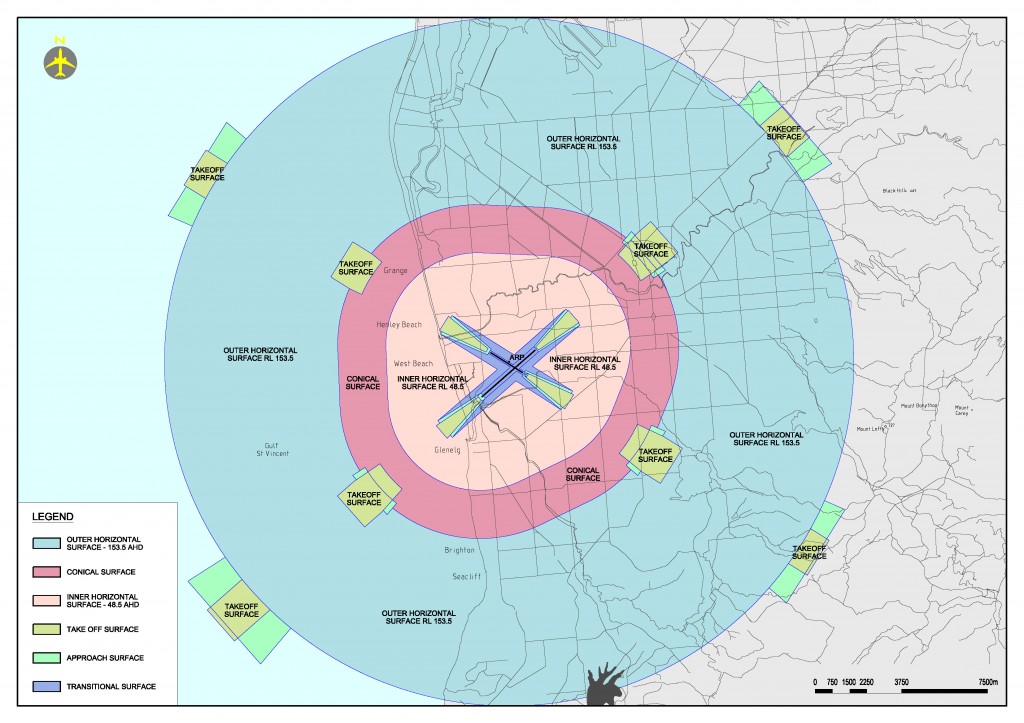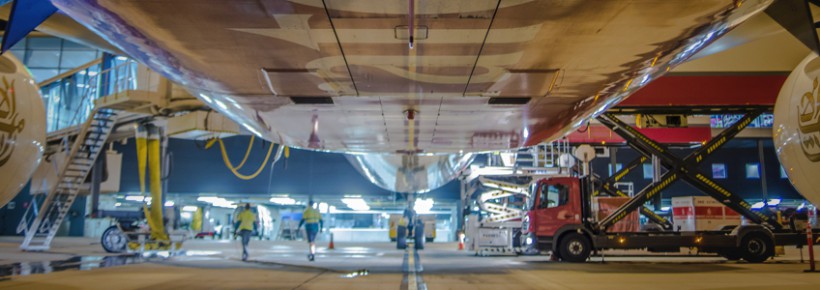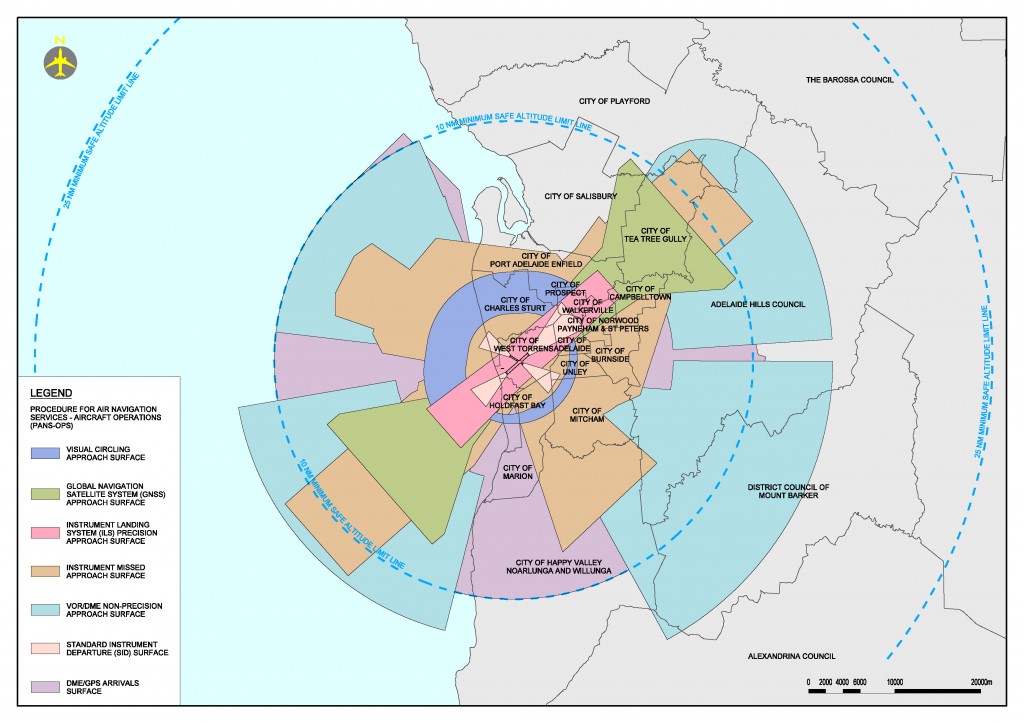Airspace Development & Crane Approvals
The protection of the immediate airspace around Adelaide Airport is essential to ensure that we maintain a safe operating environment and to provide future growth for the Airport. The airspace around Adelaide Airport is protected under the Commonwealth Airports Act 1996 and the Airports (Protection of Airspace) Regulations 1996.
Protected Airspace
International standards have been adopted which define two sets of invisible surfaces above the ground around an airport. The airspace above these surfaces forms the airport’s protected airspace. These two surfaces are the:
- Obstacle Limitation Surface (OLS); and
- Procedures for Air Navigation Services – Aircraft Operations (PANS-OPS) surface.
Obstacle Limitation Surfaces (OLS)
The Obstacle Limitation Surfaces (OLS) are a series of surfaces in the airspace surrounding an airport. They are established in accordance with the International Civil Aviation Organisation (ICAO)specifications which have been adopted by Australia’s Civil Aviation Safety Authority (CASA). The OLS defines the airspace to be protected for aircraft operating during the initial and final stages of flight, or when manoeuvring in the vicinity of the airport.
The OLS is generally the lowest surface and is designed to provide protection to aircraft when a pilot is flying visually. New developments may penetrate the OLS but only in particular locations and if strict requirements are met.
This diagram shows the OLS for Adelaide Airport. 
Procedures for Air Navigation Services – Aircraft Operations Surfaces (PANS-OPS)
All major airports have navigation aids to enable aircraft to navigate to the airport safely in poor weather conditions. The PANS-OPS are established to protect those stages of take off, landing or manoeuvring when aircraft are operating in non visual conditions and are flying using instruments.
The ICAO standard for PANS-OPS surfaces requires surfaces with the applicable obstacle clearance be defined for each published procedure.The PANS-OPS surfaces cannot be infringed by permanent obstacles under any circumstances.
The PANS-OPS surfaces for Adelaide Airport are relatively complex because for the number of published instrument procedures in place.
Controlled Activity
Any activity that infringes an airport’s protected airspace is called a controlled activity, and requires approval before it can be carried out.
Controlled activities include the following:
- permanent structures, such as buildings, intruding into the protected airspace;
- temporary structures such as cranes intruding into the protected airspace; and
- any activities causing intrusions into the protected airspace through glare from artificial light or reflected sunlight, air turbulence from stacks or vents, smoke, dust, steam or other gases or particulate matter.
The Regulations differentiate between short-term (less than 3 months) and long-term controlled activities. A short term controlled activity may be approved by the airport operator. A long term controlled activity requires approval by the Department of Infrastructure & Regional Development (DIRD).Any long term intrusions of the PANS-OPS surface are prohibited.
A person who carries out a controlled activity without approval commits an offence under Section 183 of the Airports Act 1996.
Approval Process
All applications to carry out a controlled activity are made to the airport in writing.
The approval process varies depending on the type of controlled activity.
- Short-term controlled activities can be:
- approved or refused by the Airport after consultation with CASA and Airservices, or;
- referred by the airport to the Department of Infrastructure and Regional Development for a decision.
- Long-term controlled activities penetrating the OLS are referred by the airport to the Department of Infrastructure and Regional Development for a decision after consultation with CASA, Airservices and the relevant building authority.
- Long-term controlled activities penetrating the PANS-OPS airspace are not permitted.
Building and Developments
Any development which may penetrate protected airspace should be sent to the airport for assessment by either the local council involved or relevant state government planning agency.
The application must include the following information:
- Description of the proposed controlled activity (type of building being constructed)
- Precise location (location plan);
- Elevations drawings showing the maximum overall height of the structure above the Australian Height Datum (including any antennae, lift over runs or towers)
- All chimneys and stacks on the roof with exhaust velocities greater than 4.3m/s at their outlet
Information is to be supplied electronically in Acrobat PDF format.
If you wish to make an application but need advice from the to assist with the final application, please contact the Airside Operations Manager on 08 8308 9245 or email [email protected]
Cranes Operating in Protected Airspace
Crane operations in the vicinity of the airport have the potential to create air safety hazards and to limit the operations of the Airport. For this reason planned operations must be assessed and approved under the Airports (Protection of Airspace) Regulations 1996.
Crane approvals fall into two criteria namely:
- Short term (less than 3 months) generally mobile cranes, and;
- Long term tower type cranes (greater than 3 months).
Short Term Crane Approvals (less than 3 months)
Crane operators must provide a completed Crane Assessment Form at least a week prior to the proposed crane activity.
The Airport will conduct the initial assessment of the application in terms of:
- whether the activity results in an intrusion into the OLS or PANS-OPS surface;
- the extent of the intrusion; and
- The precise location of the development or activity.
If the initial assessment results in no intrusion to the OLS or PANS-OPS surface the Airport will approve the application.
If the application results in an intrusion to the OLS or PANS-OPS surface the Airport is required to invite the following organisations to assess or comment on an application which will take approx. 2 weeks for assessment:
- the Civil Aviation Safety Authority (CASA) – for an assessment of the impact on aviation safety and shielding
- Airservices Australia – for assessments of proposals resulting in a penetration of the PANS-OPS surface or temporary redirection of flight paths
Long Term Crane Approvals (greater than 3 months)
Crane operators must provide the following information as part of an application for approval of a long term crane. The application should be submitted at least 2 months prior to the proposed erection of the crane.
The following information must be included in the application:
- Type of crane to be erected
- Erection and estimated removal dates including any staging.
- Precise location (location plan);
- Elevations drawings showing the maximum and minimum operating height of the crane above the Australian Height Datum (including any staging)
- Crane boom radius at maximum and minimum height
Information is to be supplied electronically in Acrobat PDF format.
If you wish to make an application but need advice to assist with the final application, please contact the Airside Operations Manager on 08 8308 9245 or email [email protected]
Assessment of Applications
The Airport will conduct the initial assessment of the application in terms of:
- whether the activity results in an intrusion into the OLS or PANS-OPS surface;
- the extent of the intrusion; and
- The precise location of the development or activity.
The Airport is required to invite the following organisations to assess or comment on an application:
- the Civil Aviation Safety Authority (CASA) – for an assessment of the impact on aviation safety and shielding
- Airservices Australia – for assessments of proposals resulting in a penetration of the PANS-OPS surface or temporary redirection of flight paths
- The local council authority responsible for building approvals.
Further Information
For further information please contact the Airside Operations Manager on 08 8308 9245 or email [email protected]


